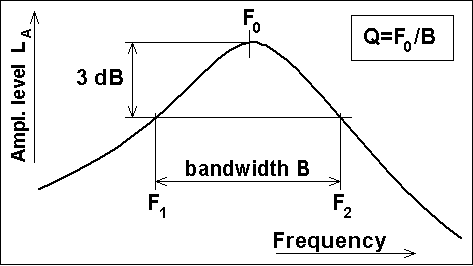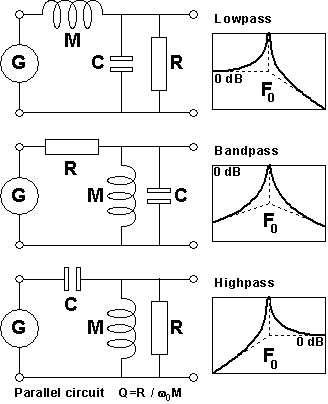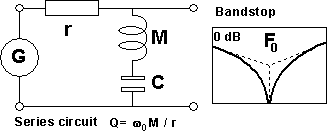|
Resonances, resonators, and characteristics of those is
an engineering topic of widespread use, particularly in
electronics, acoustics, and mechanics. A complete
treatment of this involves a good deal of math that many
students have to endure. However, let us here just briefly
illustrate with a few examples what this is all about, and
point out a few practical standard thumb rules in the
area.
What is a resonator
A resonator, whether electrical, mechanical, acoustical, or
whatever, always involves an inertial element M and a compliant
element C. You can
excite the resonator by injecting a certain energy into it.
In the resonator this energy will then periodically
oscillate between static (in the compliant member C) and kinetic (in the
inertial M).
Because of inevitable losses this oscillation will decrease
with time if the resonator is left alone. In circuit theory
the loss mechanism is represented with a resistance R.
It is customary to characterize a resonator with three
secondary properties which can be computed from its
primary R-M-C
elements:
- The resonance frequency F0, how
many cycles per second in the oscillation.
- The Q
value, the 'Quality factor', e.g. indirectly
telling how long oscillation will go on after a
momentary excitation, or the 'sharpness' of the
resonance.
- The impedance level, which gives a relation
between the oscillating energy and the observed
excursion, e.g. in terms of voltage, displacement,
pressure, etc. (This point will not be further covered
here).
There are two special ways to look at a resonator that are
particularly illustrative. One is the impulse response
in the 'time domain', the other is the frequency
response. They are classical methods that can be
worked with 'by hand' using simple instruments. Modern
computerized analyses may use several other methods, e.g.
with chirp, noise, or pseudo-random (MLSSA) signals, and
sophisticated signal processing. Often results of such
analyses are presented in the end, recomputed as one or both
of these simple representations.
These two responses are interrelated, they tell the same
story about the resonator, but in different ways. You can
translate from one to the other analytically by way of the
Laplace transform, something that is way too complicated
to enter here. You can also transform between signals in
the two domains in a computer, using the Fourier transform
(FFT).
A general observation in connection with the transform
theory is that time is an inverse to frequency, they have
a dual relation. In technical jargon you can say that the
'time window' times the 'frequency window' is unity. An
important consequence is, in plain words:
- Something that changes rapidly in time occupies a
wide range in frequency.
- Something that occupies only a narrow range of
frequencies cannot change rapidly in time.
Time domain impulse response
You set the resonance in motion with a single impulse, and
then you study how the resonance motion develops with time.
For example, pluck a string, strike a xylophone, and record
the sound wave. Typical resulting waveforms are shown in the
upper graphs in each pair in fig 1, momentary deflection (or
voltage, current, pressure, speed, etc.) vs. time.
The vertically displayed momentary value obeys
the basic function of time t:
y = A0*exp(-π*F0*t/Q)*sin(2*π*F0*t+φ)
where F0
is the resonance (or natural) frequency, and Q is the quality
factor. We return to these below. φ is a phase angle that depends on
the precise start conditions and is mostly of little
interest. The formula has a sine factor that portrays the
oscillation. The initial amplitude A0
together with the exponential function define a decreasing
momentary amplitude.
Frequency domain continuous response
You excite the resonator continuously with an external
sinusoidal signal, and then you study how the resonance
motion behaves when you vary the frequency of that signal.
This exemplifies what is often thought of as filtering.
Typical corresponding outcomes are shown in the lower graph
of each pair in fig 1, the amplitude (=peak value of
momentary deflection) vs. frequency. The frequency response
displays its resonance peak where the exciting
frequency coincides with the resonance frequency.
|
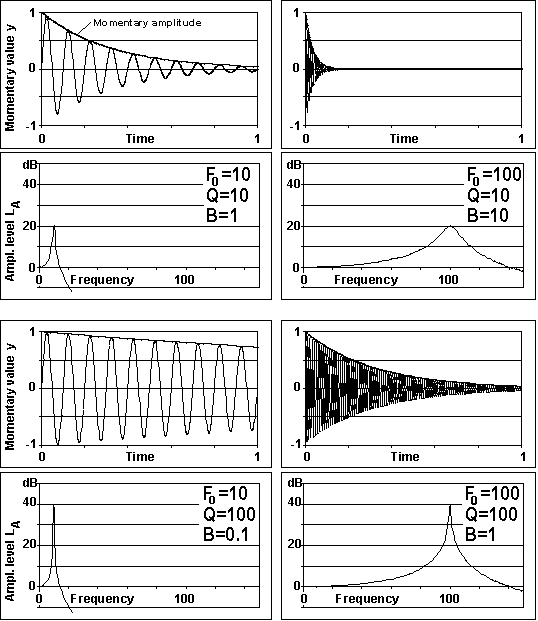
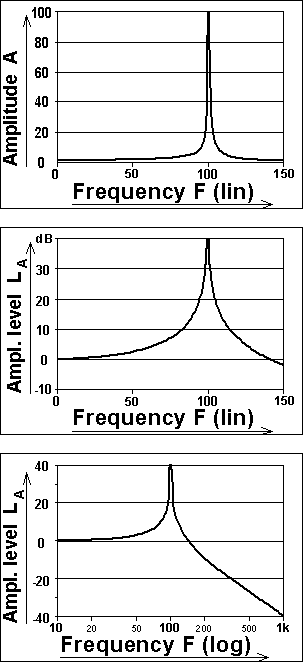
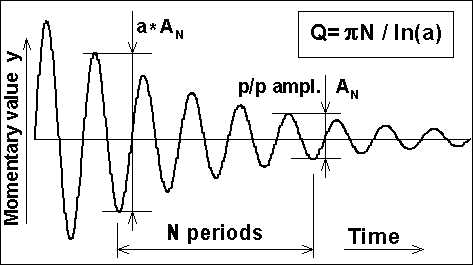 Fig
3. Finding Q from the impulse response.
Fig
3. Finding Q from the impulse response.